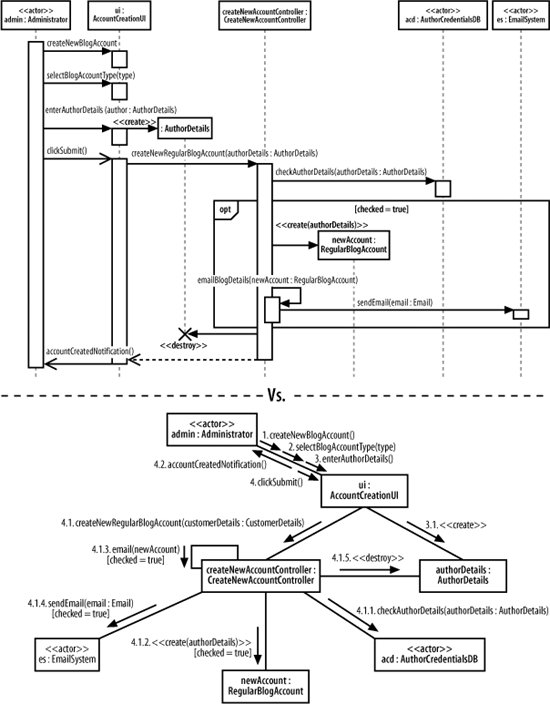Section 8.3. Communication Diagrams Versus Sequence Diagrams
8.3. Communication Diagrams Versus Sequence DiagramsCommunication and sequence diagrams present such similar information that a comparison is almost inevitable. Setting personal preferences aside, what are the best reasons for picking a sequence diagram, a communication diagram, or even a combination of both to model a particular interaction? 8.3.1. How the Fight Shapes UpFigure 8-15 shows the two different representations of the same Create a new Regular Blog Account interaction. Figure 8-15. The Create a new Regular Blog Account interaction can be modeled using a sequence diagram and a communication diagram 8.3.2. The Main EventBeyond any arguments about personal preference, and using the interaction shown in Figure 8-15 as an example, Table 8-1 compares sequence diagrams and communication diagrams to help you decide which diagram is most useful for your modeling purposes.
OK, so the fight was a little biased and tongue-in-cheek in that the features assessed were already clear discriminators between communication and sequence diagrams. Although the results shown in Table 8-1 are not really surprising, it's worth stating once again that you should:
Perhaps the most important message to take away from this comparison is that although both types of diagram convey similar information, communication diagrams and sequence diagrams offer different benefits; therefore, the best approach, time willing, is to use both. |
EAN: 2147483647
Pages: 175
- Challenging the Unpredictable: Changeable Order Management Systems
- The Second Wave ERP Market: An Australian Viewpoint
- Enterprise Application Integration: New Solutions for a Solved Problem or a Challenging Research Field?
- Data Mining for Business Process Reengineering
- Relevance and Micro-Relevance for the Professional as Determinants of IT-Diffusion and IT-Use in Healthcare